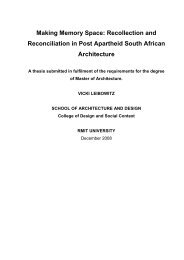Objects in Flux - RMIT Research Repository - RMIT University
Objects in Flux - RMIT Research Repository - RMIT University
Objects in Flux - RMIT Research Repository - RMIT University
Create successful ePaper yourself
Turn your PDF publications into a flip-book with our unique Google optimized e-Paper software.
pert’ advice to support their claims, manufacturers cast alternative<br />
modes of uses as both socially <strong>in</strong>appropriate and damag<strong>in</strong>g to the<br />
automobile. 3<br />
• Contractual control: The Ford Motor Company used its contractual<br />
relationship with Ford distributors to limit the availability of<br />
conversion kits. In addition to this, by identify<strong>in</strong>g specific uses as<br />
violations of the warranty and service agreement, Ford effectively<br />
conf<strong>in</strong>ed users to its prescribed modes of use.<br />
4 • Restricted product ecology: Through control of the automobile’s<br />
distribution and sale, the Ford Motor Company could establish<br />
a restricted ecology of products around the automobile and limit<br />
consumer exposure to compet<strong>in</strong>g technologies and divergent uses.<br />
• State regulation: By lobby<strong>in</strong>g government regulators, manufacturers<br />
and their representatives (specifically the American Tractor<br />
Association), attempted to <strong>in</strong>troduce laws that favored their<br />
<strong>in</strong>terpretation of object use and prohibited or stifled alternative<br />
developments.<br />
• Control through design: The physical qualities of the automobile<br />
directly affected the affordances offered the user, and hence played a<br />
major role <strong>in</strong> determ<strong>in</strong><strong>in</strong>g the uses to which the automobile was put.<br />
The highly adaptable nature of the Ford Model-T design encouraged<br />
diverse practices of use. Greater complexity of parts, use of propriety<br />
components, and restricted access to <strong>in</strong>ternal work<strong>in</strong>gs may all<br />
be deployed as design mechanisms to limit <strong>in</strong>terpretative flexibility.<br />
Control through design may also be achieved by <strong>in</strong>troduc<strong>in</strong>g new<br />
products to the market that compete with the functionality offered by<br />
divergent use. The <strong>in</strong>troduction of the Ford one-ton truck and Fordson<br />
tractor are examples of this form of control through design.<br />
Adopt<strong>in</strong>g the term<strong>in</strong>ology of de Certeau, we may describe these control<br />
mechanisms as ‘strategies’ that seek to create places <strong>in</strong> conformity<br />
with ‘abstract models’ (de Certeau, 1984, p. 29). Operat<strong>in</strong>g from a<br />
position of power, the Ford Motor Company and other manufacturers<br />
were able to claim authority over the space that constituted automobile<br />
use and dictate the ‘natural’ conditions of this space. This authority<br />
far exceeds any form of ownership granted the consumer through the<br />
act of purchase, for while the consumer may ga<strong>in</strong> possession of the<br />
object, the manufacturer cont<strong>in</strong>ues to author the object even as it sits<br />
Stategies of Control and Tactics of Use<br />
4/ I use the term ‘product ecology’<br />
here to describe the collection of<br />
products, systems and people that<br />
shape a consumer’s experience of a<br />
specific product. This understand<strong>in</strong>g<br />
follows from Jodi Forlizzi’s use of the<br />
term with<strong>in</strong> the field of human-com-<br />
puter <strong>in</strong>teraction (HCI) (Forlizzi, 2007,<br />
2008; Forlizzi and Battarbee, 2004).<br />
109
















